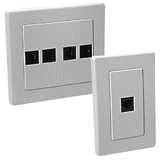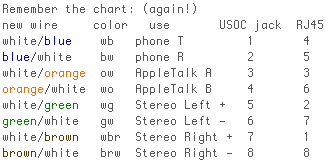OK lets get down to connections. At each 8 pin jack you have wired each pin to the correct place and the cable is running to the central spot. I should mention that the Nortel jack that I have bought are very nice but they require you to wire each of the jacks individually provided you have the dual or quad units. 
The jack illustration here is quite possibly the finest jack known to common man today. It boasts the snap on cover plate (no lost screws) and the BIX type of connection for the inside wire. With this unit you can safely plug in 8, 6 & 4 pin plugs and be assured a good connection will be maintained.
They are not prewired to both/all jacks but this is a blessing, it will allow you customize any job to your individual needs. If this is the jack of choice for your job then please don't forget to do this also. They are of such a fine quality and design it is not a bother (have I said this before?). The flush and surface mounting units are equipped with a BIX type of connection and require a special tool. At one time they came with a disposable tool (plastic single use) and perhaps are still available. If you encounter a head scratching session with these items, write to me and I will put your concerns to rest.
Further to the notion when purchasing dual or quad jacks, I have found that generally a fella never has enough places to plug his stuff into. Consider the power problem when you look under your desk or table and all the power bars and clutter just to get the every day stuff to turn on. This rule of thumb (or index finger held skyward) is you can never have too many of somethings. This is true of AppleTalk/sound/phone/modem/LAN jacks. Once you have your project underway you will understand my reasoning, thoughts will enter your mind, "Now how did I get this done before?", or "That guy must have read our minds!".

First lets review how it could be at your house now. From where the telephone service enters the building from the phone company will likely be a connecting device where all the cables are now connected. If you have one line only and this is all then not much more thought is required in planning or altering the phone setup. If you have more than one line then you must decide where each will go onto which cable. This is on the assumption that one cable for one telephone number or line. If you have a multiline type of system extensive head scratching may result and it is not entirely impossible to solve this situation for this scheme. What ever type of phone situation you have the plan of attack first is to identify each cable for future reference and ease of trouble shooting should it arise. This is best achieved at the onset and very easily by disconnecting one cable at a time and checking which phone has quit working. If you have an extra cable or two that you could not identify, now is the time to decide if it will be missed or not. Often if the 2 line household (parents/kids) situation is connected to all cables and at the jack the correct line was wired for the user at that location, be it bedroom or kitchen. This is not always required, we can use the unused wire for our needs, right.
Once this is done and determination of the amount of conductors in each cable is adequate for the room it serves you can proceed with connecting the new and old. From the shopping list you prepared if you bought a central connecting device for the extra cables, now is the time to use it. The idea is to multiple all appearances of the AppleTalk and telephone to all of the locations you require same. This also applies to the stereo sound but if you have a multi zone system (system A, B or C) this is the time to make the choice as well. My main floor is system B, upstairs is C and the basement is A. My stereo also allows for A+B and just A or just B and so on, this way impedance problems are solved internally by the designers of the amp. This would help when you have the tunes in the bathroom and the kitchen but not the bedrooms early in the morning to hear the morning news (sleeping children, et al). To do this simply connect the cable going to the HiFi as follows:
new Wire.....Color...Use
white / blue . wb . Stereo Left + A
blue / white . bw . Stereo Left - A
white/orange . ow . Stereo Right+ A
orange/white . wo . Stereo Right- A
white /green . wg . Stereo Left + B
green /white . gw . Stereo Left - B
white /brown . wbr. Stereo Right+ B
brown /white . brw. Stereo Right- B
(written with a non-proportional font (Monaco) and I hope it looks OK to you, It does here).
Of course this assumes you have just this cable from the stereo system to the central spot wired in this manner. At the central spot you use either system A or B to multiple to the particular cables for the system required. Remember if you have a separate cable for each left and right channel that these must be connected to have stereo and you never know if you want to reverse the orientation just unplug and swap the 2 speakers. You remember the speaker plug itself is the item that decides if it is a right channel speaker or left channel speaker. Another benefit is you will be able to suddenly find a use for those old speakers you have in the attic and maybe use these outdoors or in the garage. Keep in mind no dancing when working under the car. Safety first you know.
As a precaution to any job trust a DMM or similar meter/device to test and make sure you have not stapled through a cable or cut a wire somewhere before you apply power. You would not want the phone to ring and hear the speakers rumble or similar disappointment.
Bringing it home...
The end result is you want to connect all cables to all other cables, in the fashion that suits the need of the house. By this I am trying to say the cables that will have the AT present will be connected to the wo & ow of each other. From the chart at the top of the page, each AT has an "A" lead & a "B" lead. Connect each "A" to "A" and each "B" to "B". Do not needlessly worry about which is the master leg of the AppleTalk because there is not one. You only have to worry about the master leg for the stereo if you have more than one speaker zone, and I hope I have that covered.
By the fashion of the house I am saying the AppleTalk in the bathroom would not be prudent, but at the hot tub outside, perhaps.
![]() NOTE: I know what you are thinking, that pesky problem of speaker impedance. Well if you are familiar with ohms law you can rest assured to figure it out for yourself. Or use the rule if you have a set of speakers going on one of the speaker selections from the amp DO NOT connect another. That is if system A has a pair running now do not connect a second pair to the same system unless your system can run on a 4 ohm load. To solve this first plan ahead to reason if the need may arise and avoid the wiring before hand. Another precaution that I used is a switch which will kill a set of speakers and yet sink the signal through a pair of power resistors to avoid any trouble. Often this is used when the door bell rings and you want to speak with the caller. The switch control is located near the hallway to the doors. Murphy says: If you are at the farthest point in the house from the volume knob, the phone will ring. If you are in the shower the answering machine will pay for itself. I will not risk running on wet floors to get asked if I want to switch long distance companies by some sales telemarketer/vulture.
NOTE: I know what you are thinking, that pesky problem of speaker impedance. Well if you are familiar with ohms law you can rest assured to figure it out for yourself. Or use the rule if you have a set of speakers going on one of the speaker selections from the amp DO NOT connect another. That is if system A has a pair running now do not connect a second pair to the same system unless your system can run on a 4 ohm load. To solve this first plan ahead to reason if the need may arise and avoid the wiring before hand. Another precaution that I used is a switch which will kill a set of speakers and yet sink the signal through a pair of power resistors to avoid any trouble. Often this is used when the door bell rings and you want to speak with the caller. The switch control is located near the hallway to the doors. Murphy says: If you are at the farthest point in the house from the volume knob, the phone will ring. If you are in the shower the answering machine will pay for itself. I will not risk running on wet floors to get asked if I want to switch long distance companies by some sales telemarketer/vulture.
To be sure check the specs supplied with your amp/receiver/HiFi to be certain. If your system will put up with an impedance of 16 ohms rather than 4 ohms, this can be achieved but it involves shorting plugs to make life simple again. Write me if you are uncertain what this could mean and I will add this explanation to the page.
 Show
your colors, May The OS Be With You!
Show
your colors, May The OS Be With You!
At one point or another there maybe proprietary devices or descriptions mentioned.
Trademarks and Copyrights belong to those that hold them, and they should have a pat on the back if I mention them here.
A personal note, if I ever get my mitts on a digital camera you will see in glorious color what a working project looks like.
At all times when reading these meager few pages imagine you are seeing fancy graphics and full color illustrations.